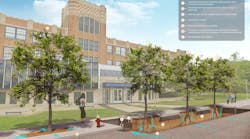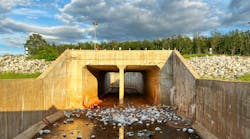The Elephant in the Room
About the author:
Mindy Hills is R&D project manager at Contech Engineered Solutions. Hills can be reached
at [email protected].
When selecting green infrastructure (GI) practices, the more burdensome task of maintenance often is not considered. Premature bypass, delayed drain down times and pollutant export often go unnoticed, especially when visual assessment becomes more difficult due to overgrown vegetation or limited site access.
Practices that are front and center in the landscape may get the extra attention, but there are many that are unsightly due to placement in more isolated areas, epitomizing the expression “out of sight, out of mind.” We hire landscapers to maintain our landscapes, so why not hire them to maintain our GI practices? The extra step to remove sediment and debris or remove and replace spent mulch is no different than the labor or tools to replace dead plants or sod and replenish new mulch in the landscape. There are educational programs available to landscapers to also become certified maintenance providers of these practices.
Without maintenance, you begin to lose some of the attributes that initially prompted the specification of the practice. With bioretention practices in particular, increased loading and lack of mulch replacement can lead to hydraulic capacity restriction and increased drain down times.
Delayed drain down ultimately may lead to anaerobic conditions, triggering phosphorus export and a decline in the aerobic microbial community necessary for pollutant breakdown and transformation. Delayed drain down can promote mosquito havens and “wet feet” conditions for plant roots, leading to plant die-off. Infiltration and groundwater recharge become compromised with increasing sediment and pollutant loading. Sediment loading over time can become toxic with increasing contaminate accumulation, turning into a leachate cesspool and hurting the flora and fauna.
GI practices should be designed for semiannual to annual minimum maintenance cycles. Shorter maintenance cycles can create a financial burden for the owner. Longer maintenance cycles allow increased sedimentation and potential hydraulic restriction. Semiannual to annual maintenance allows for proper vegetative pruning not only for aesthetic value, but also to preserve access for sediment, debris and spent mulch removal during future maintenance visits between the vegetative plantings.
Maintenance also allows diagnosis of issues that are not obvious at installation of newer systems. Standing water could suggest flow restriction and premature bypass may be occurring. Evidence of excessive scour can cause short-circuiting, but can be corrected with appropriate energy dissipation stone or flow splitter installation. Slopes can be assessed for proper vegetation establishment during maintenance visits and replanted or regraded as necessary if compaction or channelization is observed. Dead plants may be an indication of a more severe issue, as plants can serve as visual health indicators. Ensuring adequate plant coverage was established helps maintain permeability and supports pollutant uptake via phytoremediation.
Algal growth present on the surface or within the media is another indication of delayed drain down times. A removal of the cleanout cap could show standing water in the system that would not have been evident from an aboveground visual assessment. During maintenance we must assess all critical components to ensure long-term operational success.
When we are providing minimal treatment and runoff reduction with our GI practices due to lack of maintenance, not only are we no longer meeting storm water quality and quantity criteria, we essentially are no longer a green practice. Maintenance should be a forethought in the project planning and design phase. It should be a specification in the plan to help ensure water quality and hydraulic sustainability rather than enduring later expensive restorative costs. Following stringent design criteria—such as pretreatment, properly sizing the practice, and following proper plan review to ensure landscaping plans, site access and erosion and sediment control details are included in the preliminary project phase—will help reduce the maintenance burden over the life of the practice.


